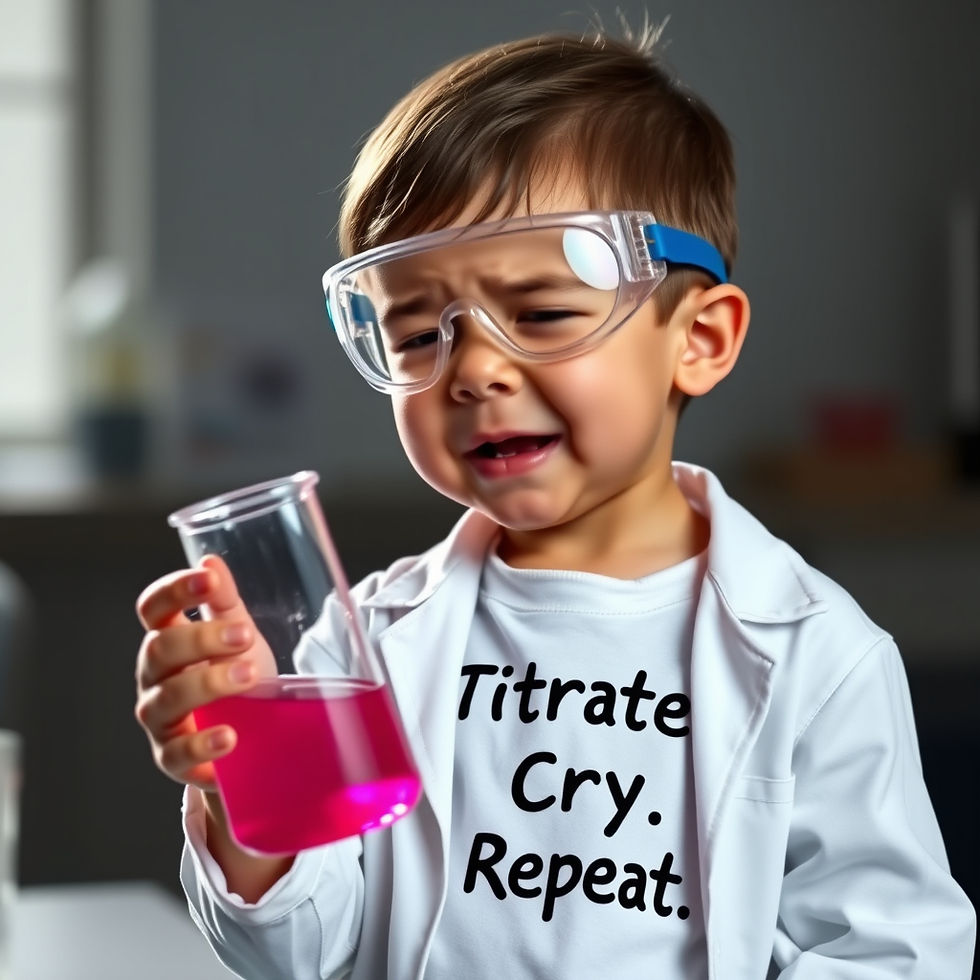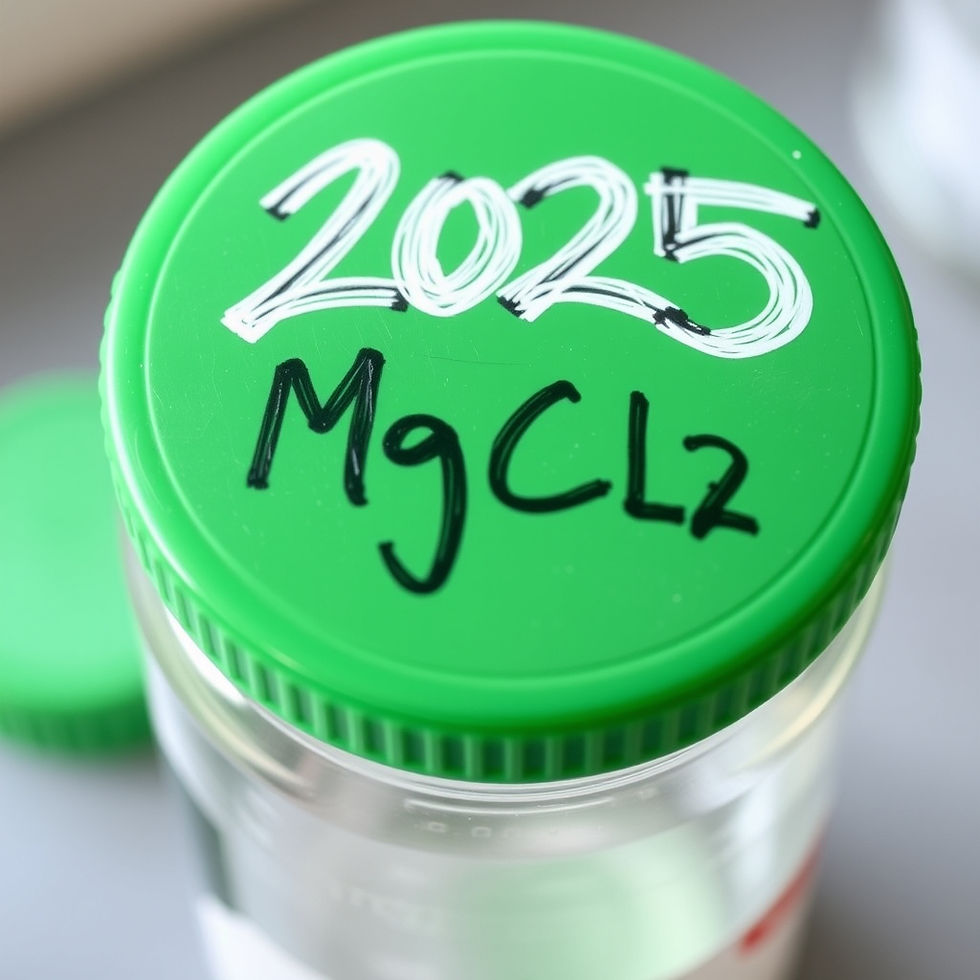Titrate. Cry. Repeat. How the Blind Titration Challenge improved acid-base titration.
- Brennan Koch
- Oct 24
- 4 min read
I love competition in the lab. Especially at the AP chemistry level. Every year I have the students compete to see who can get closest to the correct molarity in the “Titration of X Molar Strong Acid Lab.” The kids love competing to see which group can land on the faintest pink solution. They will fight to the half drop of sodium hydroxide to win that one. I told them that other teachers post pictures of good results on social media. They kept asking, “Is this titration Insta-worthy?”. As long as I kept telling them “No”, they kept trying harder. It’s a fun way to up the stakes. This year, I added a final challenge to the lab, and they loved it. I call it the Blind Titration Challenge. It forces them to be careful. It causes them to apply their math very specifically. It made them focus on the content. Here is how the Blind Titration Challenge works…
Complete a standard strong acid titration
The goal of the lab is to introduce them to acid-base titration. I teach them how to prep a burette. We walk through the logic of MAVA = MBVB. We discuss the use of phenolphthalein and why changing color at a pH of 8.3 isn’t the worst problem. But it does mean that you don’t want to be over on the titration, since the pink indication is already technically past equivalence.
I mix a standardized solution of 0.1000 M NaOH. This is the titrant that will be in the burette.
Pro Tip: Teach the students to prepare burettes themselves. Rinsing with the titrant has showed up on the AP test as a point a few times over my 20 year span.
The students measure 25 mL of the X M HCl. They add a couple drops of phenolphthalein and they are off to the races. After two or three successful trials, they calculate the molarity of the HCl. They write their averages on the board and compete for some lab points as to who is the closest.

Introduce the blind titration
The idea of the blind titration came from a student who had messed up. I don’t know why, but I find it darkly funny when a group is titrating, and they keep adding and adding the base. Way past what they figure should have been the equivalence point. That’s when they ask me what I think is wrong. I scratch my beard, rub my bald head in cinematic thinking methods. Then I add the drops of phenolphthalein that they obviously forgot to include. The solution turns dark fuchsia. They ask each other, “I thought you put it in,” pointing at each other. After one of these unfortunate events, a student asked a simple question. “Does the titration work without the phenolphthalein?” Of course it does. We are just neutralizing an acid. We just need an indication to tell when they are equivalent. And thus was born the Blind Titration Challenge.
Complete the Blind Titration Challenge
At the end of the lab, after the groups have successfully calculated the molarity of the unknown acid, they will compete in the Blind Titration Challenge. The winner is the group that gets the faintest pink solution (and it must be pink) by adding the phenolphthalein AFTER the titration. There is no indicator in the solution as they titrate. I also don’t give them the same volume of HCl to add to the beaker at the bottom. This year I chose 17 mL (when they had been using 25). That is all the instruction that I give them. Make it faint pink. But I get to add the phenolphthalein at the end.
They put their heads together and start brainstorming how they will know how much NaOH to add. They generally start by guessing. Since the volume of HCl is less, they need to add less NaOH. Then the light bulb turns on. Since it’s the end of the lab, they know the molarity of the acid! A few hurried seconds later in their calculators and they know just how much base to add. They titrate the 17 mL with their calculated amount of NaOH. It is so fun to watch them arguing.
“We need one more drop.”
“No, we don’t! That will make it too pink!”
And finally, the reveal. After each group has added their calculated amount of NaOH, they bring their clear solutions to the main table. Each group, nervously checks out the others. Then with much fanfare, I add phenolphthalein to the titration. The kids stare excitedly as the first drop touches the solution. Please turn pink… but not too pink! One by one they get to see the results of their blind titration. Then we have to argue over who’s actually wins. Sometimes it’s easy. This beaker is still clear. Disqualified. That one is 1995-windbreaker pink. Too dark. And this one is just hinting at pinkness. The winner!

The kids loved the extra challenge. Plus, it forced them, after their very first titration, to use the skills that they learned and apply it mathematically. That is exactly what you, as a teacher, want to happen in a lab. The kids learn a new lab skill. Apply it carefully. Learn the mathematical reason behind the process. Apply the math skill back to a new lab procedure. It makes a much more engaging end to the titration lab. Plus, the kids begin to learn the meaning of our titration slogan. Titrate. Cry. Repeat.
It's all about engaging your students' minds in new ways. Have you tried Stoich Decks games? I had a student just yesterday come seek me out after class to tell me that she didn't understand a concept UNTIL she played the game. Now she does! That's exactly the point. See that glimmer in your students' eyes as they add to their understanding by playing curriculum-centric games. Check them out today.





Comments